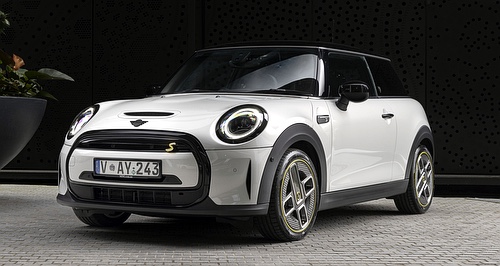World Electric Vehicle Day pushes EV agenda

WORLD Electric Vehicle Day (WEVD) is this Friday, September 9, when owners and anyone with an interest in pure electric vehicles is encouraged through social media platforms to network and physically meet to further the EV cause.
Car-maker Mini is marking WEVD with the local relaunch of its pure electric Mini Electric model that was initially launched here back in mid-2020 with not much fanfare due to COVID-19 restrictions.
The cool-looking electric city car, still utilising a chassis adapted from internal combustion engine days, exudes Mini’s cheeky persona in the way it looks and goes but you’ll pay for the privilege as Mini Electric in entry SE Classic spec’ goes for $55,650 plus on-road costs – or a ten grand premium over the 2.0-litre petrol powered S Classic.
Two other electric variants are available, the SE Yours at $62,825 and the Resolute Edition, based on Yours with additional kit and a special olive-green paint at $63,825, both plus ORCs.
“We are relaunching Mini Electric Hatch to coincide with World Electric Vehicle Day because it ushers in our path to 2030 when all Minis will be EVs,” said Mini Australia head of product James Orlov.
“This will be the last Mini EV based on an adapted internal combustion engine platform as a new dedicated EV platform comes on stream in 2025, and Mini will be the first in BMW Group to go all electric.”
But from an international perspective, some commentators ask if a WEVD is relevant as issues that could be driven by such a lobby appear to be subsiding in many countries.
The acceptance and sales of EVs internationally is growing exponentially particularly in Europe and China where government is pushing the EV agenda with financial incentives along with the provision of EV infrastructure.
That’s to say nothing of global climate emergencies and high fuel prices which would no doubt be driving sales.
Here in Australia, it’s a different story as affordability and lack of recharging facilities are arguably the main hindrance to EV uptake giving lobby groups such as WEVD more currency.
As an EV adopter, Australia is lagging according to federal climate change minister Chris Bowen who said at the recent EV summit in Canberra that the uptake of zero- and low-emission vehicles is currently constrained, among other issues, by a combination of high prices, limited stock and long waitlists for a range of models that is much smaller than available overseas.
“Uptake of new low-emissions vehicles sits at just two per cent, nearly five times lower than the global average,” said Mr Bowen.
“There are many consumers who would be interested in buying an EV but even if they could access the limited stock available, price sends them to petrol or diesel models.”
Mr Bowen said estimates suggested Australia is currently about a decade behind Europe in electric vehicle policy and uptake.
As of September 1, 2022, there are 37 BEVs available in Australia ranging in price from $45,000 plus ORCs for the MGZS EV through to $350,000 for the Mercedes-Benz EQS luxury sedan.
But new data suggests electric vehicle affordability in Australia is out of reach of most new car buyers.
Recent pricing forecasts from automotive data agency Blue Flag suggest the average Australian household income falls well short of that required to purchase a new electric vehicle.
The Melbourne-based company says its data was compiled based on communication with a range of organisations from government agencies to international and leading automotive brands.
By 2025, Blue Flag estimates that of the 133 new electric car model ranges expected to enter the Australian market, 22 will be priced above $150,000, 24 between $100,000 and $150,000, and 20 in the $80,000 to $100,000 range.
It says most new battery electric vehicle (BEV) models due to go on sale before the middle of the decade will be priced within the $60,000 to $80,000 range (47), with 19 models to be offered in the $40,000 to $60,000 bracket, and just one below $40,000.
Indications are that EV prices are unlikely to drop below the $40,000 mark.
This is all with a backdrop in Australia of stagnant wage growth and growing inflationary pressures.
An additional 18 new BEVs are due to go on the market by the end of the year indicating the local EV market is growing organically.
So called “range anxiety” appears to have been addressed with some BEVs capable of 620km range according to Worldwide Harmonised Light Vehicle Test Procedure (WLTP) parameters.
Sales data from Europe in particular, suggest buyers are skipping over plug-in hybrids (PHEV) and hybrid petrol/electric (HEV) models instead opting for BEVs straight up.
The same scenario is likely to prevail globally despite many car-makers incorrectly predicting a transition through hybrids to fully electric… and structuring production schedules accordingly.
In Australia, support for WEVD has come from most EV car-makers, government and other groups like the Australian Electric Vehicle Association (AEVA) that is a volunteer run, not-for-profit organisation dedicated to the cause of switching Australia's transport networks to electric drive as quickly as possible.
The AEVA is the longest continuously running EV society in the world, formed after the oil price shocks of 1973.
Various proponents of WEVD provide a forum for social and technical communication in the EV space, create greater awareness of EVs, encourage their use to foster further research and development in EV technology and provide a source of information.